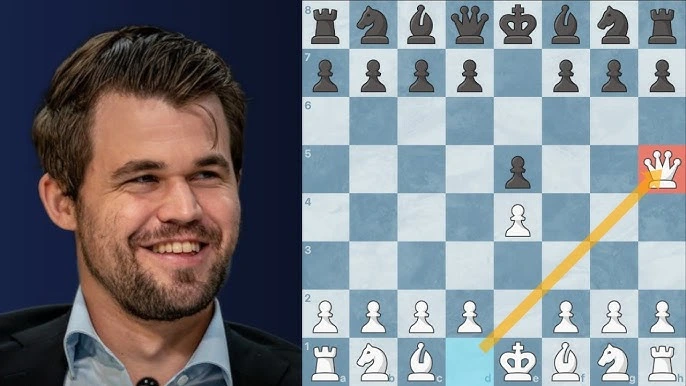In chess, most games last dozens of moves. But sometimes, if your opponent isn’t careful, you can win in just four moves. That’s what’s called Scholar’s Mate – one of the quickest and most famous checkmates in the game.
Even Magnus Carlsen, the world number one, has explained it with a smile: “I’m going to explain the best opening for beginners…” And while it’s not the most reliable trick against experienced players, it’s a fun way to learn about checkmate patterns, piece coordination, and the importance of defending early.
The Idea Behind Scholar’s Mate
The plan is simple:
- Bring your queen out early. This is usually not recommended in serious play, but here it’s the key to the trap.
- Target the weak f7 square (for Black) or f2 square (for White). These pawns are only defended by the king at the start of the game.
- Bring out your bishop to join the queen in attacking that weak square.
If your opponent ignores the threat, you can deliver checkmate almost instantly.
The Classic Move Order
Here’s how it works from White’s perspective:
- e4 – You open the center and free your queen and bishop.
- … e5 – Black plays symmetrically.
- Qh5 – Your queen jumps out, aiming straight at the pawn on f7.
- … Nc6? – If Black develops a knight but ignores the queen’s threat…
- Bc4 – The bishop lines up with the queen, both attacking f7.
- … Nf6?? – Black tries to attack your queen, but this is a blunder.
- Qxf7# – Checkmate. Game over.
Carlsen joked about this moment: “There we go. That is a checkmate.”
When You Get Lucky
Sometimes your opponent plays even worse. Carlsen gives an example: if Black tries to attack your queen too soon without defending properly, you might win even more material before delivering mate. For instance:
- After Qh5, if Black plays g6??, you can take the rook in the corner after a few moves.
- That’s why Carlsen grinned and said: “And isn’t that a fantastic start to the game?”
When Your Opponent Is Smart
Of course, against a cautious player, you won’t land the quick mate. They might defend with g6, Qe7, or Qf6.
In that case, you don’t just keep chasing checkmate blindly. You pull your queen back, keep your pieces safe, and start developing normally:
- Bring out your knights.
- Push your pawns.
- Castle your king.
Even if Scholar’s Mate doesn’t work, you’ve still started the game with an attack-minded approach.
Why It Works on Beginners
Scholar’s Mate works because new players often focus only on their own plans and forget to watch for threats. The f7/f2 pawn is a known weakness, and if they don’t defend it, the game can end before it really starts.
But here’s the truth:
- Once a player has seen Scholar’s Mate once, they’ll almost never fall for it again.
- That’s why Carlsen admitted with a smirk: “Though I haven’t tried.”
Lessons from Scholar’s Mate
Even though it’s a beginner’s trap, Scholar’s Mate teaches valuable lessons:
- Always look for threats to your king.
- Don’t bring your queen out too early in serious games — she can become a target.
- Coordinate your pieces — queen and bishop working together can be deadly.
- Development matters — defending smartly while improving your position wins games.
Final Thoughts
Scholar’s Mate is like a magic trick: spectacular the first time you see it, but it only works on people who don’t know the secret. It’s not something you’ll see in high-level chess, but it’s a fun way to learn about checkmate and piece teamwork.
So, try it out with your friends. If it works, you’ll feel like a genius. If it doesn’t, you’ll still have started the game actively, and that’s never a bad thing in chess.
As Carlsen did say: “There you go, kids — the best opening for beginners. Scholar’s Mate.”

I’m a passionate board game enthusiast and a skilled player in chess, xiangqi and Go. Words for Attacking Chess since 2023. Ping me at Lichess for a game or chat.






